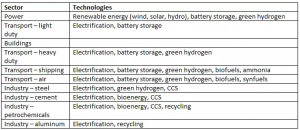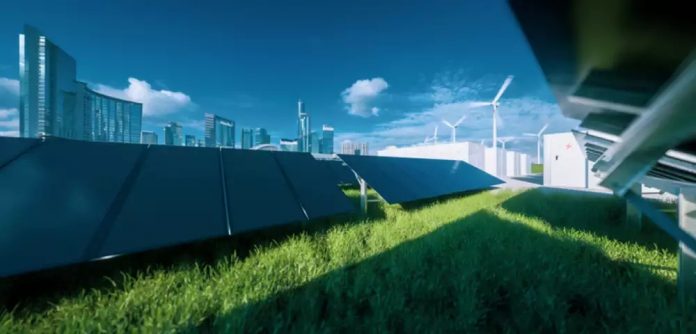To avoid climate catastrophe, we need to keep global warming to below 1.5 Degree Celsius (ETC, 2017; ETC, 2018; ETC, 2020). This would require cutting down our emissions to net-zero by 2050, where net-zero allows for carbon removal in case absolute emissions do not go to zero. In this thought piece we examine this key issue, by answering a series of related questions.
Which are the key sectors?
Given that 75 per cent [1] of overall emissions are due to energy consumption, in this thought piece we focus on energy [2]. Within energy, some sectors are considered easier to decarbonize (ETC, 2017), whereas some others are called hard to abate sectors (ETC, 2018; ETC, 2020). This distinction is largely based on commercial availability of low-carbon technologies.
In the former category, the power sector is considered the lowest hanging fruit, followed by light duty transportation (eg. cars) and building sectors. The latter category, on the other hand, includes heavy duty transportation (eg. trucking, trains, shipping, and air) as well as industry (eg. steel, cement, petrochemicals, and aluminum).
What are the key technologies?
While there is a distinction across sectors, the good news is that technologies are available today that would allow for complete decarbonization of each of these sectors (ETC, 2018; ETC, 2020). In the table below, we provide a summary.
 OPINION: Getting to net-zero is not only technically feasible but economically viable too
OPINION: Getting to net-zero is not only technically feasible but economically viable too
As we can see, significant progress can be achieved via demand reduction and energy efficiency, followed by electrification, followed by supplemental technologies (ETC, 2018). From this table, key technologies include the following (ETC, 2020): renewable energy (i.e. wind, solar, hydro), battery storage, green hydrogen, bioenergy, and carbon capture and sequestration (CCS).
While some of these technologies are commercially ready now (eg. renewable energy and battery storage), some are likely to become ready over the next decade (eg. bioenergy, green hydrogen, and CCS). That is, given appropriate focus on developing these technologies, we have a technically feasible path to net-zero.
What are the key pathways?
As discussed earlier, there are three main routes to deep decarbonization (ETC, 2018): one, improving energy efficiency of underlying processes; two, reducing demand for carbon-intensive products and services; and three, deploying decarbonization technologies – i.e. clean electricity, biomass energy, CCS, and green hydrogen – across all sectors.
It is predicated that, to fully decarbonize the energy sector, we would need to deploy green technologies at scale, including the following (ETC, 2020): renewable electricity generation will need to reach 90,000-115,000 TWh per year, whereas green hydrogen generation would need to reach 800-900 Mt per year. This will also entail significantly expanding the capacity for CCS as well as bioenergy production.
Given the technical, economic, and institutional barriers, transition paths will vary significantly by sector (ETC, 2020). In the electricity sector, the progress to full decarbonization is already on the way. In the industrial sectors, progress to full decarbonization will inevitably take several decades. In the transport sectors, transition paths are less complicated, and it is likely to decarbonize next after electricity.
What are the incremental costs?
Building a zero-carbon economy by mid-century will require a dramatic acceleration in the pace of investment over the next 30 years (ETC, 2020). We would need to scale up renewable electricity, hydrogen production, and CCS capacity by six, fifteen, and eight times, respectively, of current levels. The macroeconomic cost of this huge investment is affordable, amounting to just 1 per cent to 2 per cent of global GDP.
The impact of decarbonization on prices faced by end consumers will vary by sector but will overall be small (ETC, 2018). Decarbonizing steel will add less than US$180 to the price of a car, while zero-emissions plastics will add less than US$0.01 to the price of soft drinks. If low-carbon fuels remain more expensive, ticket prices for international flights may increase by 10-20 per cent; nevertheless, given this accounts for less than 3 per cent of household consumption, the total impact would still be low.
What is the role of policy?
But this deep decarbonization will not happen unless countries set clear targets for emissions reduction and deep electrification, with policies to support key technology developments, price carbon, drive energy efficiency, and ensure key infrastructure developments (ETC, 2020). International coordinated action is also required to mobilize the significant capital flows needed to finance rapid renewable electricity development in developing countries.
Optimal policies must not only ensure that a zero-carbon emissions economy is achieved by mid-century but also reflect feasible transition paths. For example, in shipping, the long-term zero-carbon solution may entail burning ammonia in ship engines, with the ammonia in turn made from zero-carbon hydrogen. But it will take many years to build the production capacity and distribution handling infrastructure required to support large-scale ammonia use.
References:
ETC (2017), Better Energy, Greater Prosperity | ETC (energy-transitions.org)
ETC (2018), ETC_MissionPossible_ReportSummary_English.pdf (energy-transitions.org)
ETC (2020), Making Mission Possible: Delivering a Net-Zero Economy (energy-transitions.org)
1. See Global Greenhouse Gas Emissions Data | Greenhouse Gas (GHG) Emissions | US EPA
2. The rest of the emissions are from forestry and land use.






